Caryn
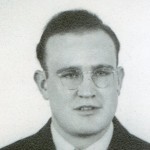 As this day has approached, I have found it very hard to believe that my Uncle Bill Spencer, my dad’s brother, is turning 95 years old today. I remember the uncle from my childhood, full of life, and exciting stories. He was the man who taught me the game of Cribbage and challenged me to try to beat him. He never gave me the game, but rather made it a true victory when I was able to beat him. He never made me feel like a failure when I lost either, but rather told me that every game I played made me a better player, and he was right. I loved the times we had together playing cribbage. It will always be one of my favorite memories of my uncle. Over the years, we tried in vain to figure out a way to play long distance. That was one challenge that beat us. I suppose that in the age of computers, we might have found a way.
As this day has approached, I have found it very hard to believe that my Uncle Bill Spencer, my dad’s brother, is turning 95 years old today. I remember the uncle from my childhood, full of life, and exciting stories. He was the man who taught me the game of Cribbage and challenged me to try to beat him. He never gave me the game, but rather made it a true victory when I was able to beat him. He never made me feel like a failure when I lost either, but rather told me that every game I played made me a better player, and he was right. I loved the times we had together playing cribbage. It will always be one of my favorite memories of my uncle. Over the years, we tried in vain to figure out a way to play long distance. That was one challenge that beat us. I suppose that in the age of computers, we might have found a way.
Uncle Bill is a unique kind of person, in that he found something he was interested in when he was just an 8 year old boy, and he never lost his passion for it. For Uncle Bill, that passion was for his 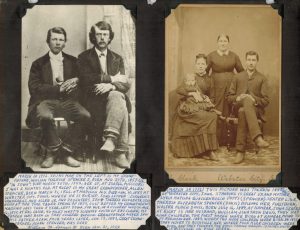 family genealogy. As a young boy, he saw a little black book his mother was working on. It was a simple record book of the family members she knew of at the time, but for Uncle Bill, it was a challenge. He was hooked, and for as long has his memory lasted, Uncle Bill continued digging for more information. His work would take him on many trips to pour through libraries, county records, state records, and to walk miles and miles of cemeteries. He had a need to find out about his past. He found himself feeling annoyed when people didn’t properly mark photos and documents, with important information, such as who was in the picture, when it was taken, and what was going on. So much information is so easily lost because someone didn’t take a moment to properly document a picture. Since I have looked over all his work, I can understand his frustration, because there are pictures that we know the relationship of, but not the name of the person, and some people we don’t know anything about at all. And no way to find out. History lost…maybe forever.
family genealogy. As a young boy, he saw a little black book his mother was working on. It was a simple record book of the family members she knew of at the time, but for Uncle Bill, it was a challenge. He was hooked, and for as long has his memory lasted, Uncle Bill continued digging for more information. His work would take him on many trips to pour through libraries, county records, state records, and to walk miles and miles of cemeteries. He had a need to find out about his past. He found himself feeling annoyed when people didn’t properly mark photos and documents, with important information, such as who was in the picture, when it was taken, and what was going on. So much information is so easily lost because someone didn’t take a moment to properly document a picture. Since I have looked over all his work, I can understand his frustration, because there are pictures that we know the relationship of, but not the name of the person, and some people we don’t know anything about at all. And no way to find out. History lost…maybe forever.
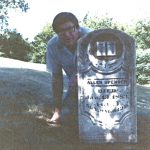 When my girls, Corrie Petersen and Amy Royce were in grade school, they had an assignment concerning their family history. My mom, Collene Spencer said I should get a hold of my Uncle Bill…his reputation as the family historian had preceded him. I called him, and he sent what was needed for their assignments. That was awesome, but it was not the end of the story. With Uncle Bill’s way of peaking my interest, I have picked up the torch and I am running with it. I pray that I can do him proud. Uncle Bill has dementia now, and doesn’t remember that he was working on the family history, Still, I pray that I, and others like me, can carry on his legacy for him, so that history will not be lost in this family. Today is Uncle Bill’s 95th birthday. Happy birthday Uncle Bill!! Have a great day!! We love you!!
When my girls, Corrie Petersen and Amy Royce were in grade school, they had an assignment concerning their family history. My mom, Collene Spencer said I should get a hold of my Uncle Bill…his reputation as the family historian had preceded him. I called him, and he sent what was needed for their assignments. That was awesome, but it was not the end of the story. With Uncle Bill’s way of peaking my interest, I have picked up the torch and I am running with it. I pray that I can do him proud. Uncle Bill has dementia now, and doesn’t remember that he was working on the family history, Still, I pray that I, and others like me, can carry on his legacy for him, so that history will not be lost in this family. Today is Uncle Bill’s 95th birthday. Happy birthday Uncle Bill!! Have a great day!! We love you!!

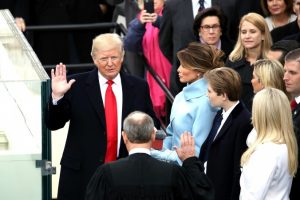 As I watched the “peaceful transition of power” from on president to the next today, I was quite moved by the prayers, the oath of office, and of course, the amazing speech given by President Donald J Trump. For those who chose Donald Trump, it was a joyous day. For those who didn’t choose him, I hope that his speech gave you some hope that the future can be bright, and less scary than you had expected it to be. Change is always something met with anticipation. It is different for everyone. Those who don’t like the change, meet it with concern, and those who like the change, meet it with joy. For me, the speech gave hope…hope of unity, prosperity, freedom, safety, and thanksgiving, but mostly of bringing God back into our country. You see, I am a patriot. I believe that this country was founded on Judeo-Christian principles, and I want God back in this country.
As I watched the “peaceful transition of power” from on president to the next today, I was quite moved by the prayers, the oath of office, and of course, the amazing speech given by President Donald J Trump. For those who chose Donald Trump, it was a joyous day. For those who didn’t choose him, I hope that his speech gave you some hope that the future can be bright, and less scary than you had expected it to be. Change is always something met with anticipation. It is different for everyone. Those who don’t like the change, meet it with concern, and those who like the change, meet it with joy. For me, the speech gave hope…hope of unity, prosperity, freedom, safety, and thanksgiving, but mostly of bringing God back into our country. You see, I am a patriot. I believe that this country was founded on Judeo-Christian principles, and I want God back in this country.
I have watched many inaugurations in my lifetime, and maybe I missed it, but I was disappointed by the outgoing side’s continual attempts to plug their message…a message that contained one very large mistake in my mind. Everyone kept calling our country a democracy. It is not. We are a Constitutional Republic…and not a Democracy as some would have you believe. A Constitutional Republic has a Constitution that limits the powers of the government. It also spells out how the government is structured, creating checks on its power and balancing power between the different branches. Our founding fathers knew very well the meaning of the word “democracy,” and the history of democracies. They were deliberately doing everything in their power to prevent the United States from being a democracy. The people in a Constitutional Republic have no obligation to the government, but rather, the government is a servant of the people, and obliged to its owner, We the People. Many politicians have lost sight of that fact, and that has been a major flaw in the outgoing administration. A Democracy, on the other hand, is a government of the masses, where authority derived through mass meeting or any other form of “direct” expression. It often results in mobocracy, where mobs, the offended, and protestors try to change how things run…sound familiar. Our current administration has done it’s best to incite these kinds of changes, and it is harming our country. It is my prayer that We the People, will begin to remove the idea of democracy from this nation, once and for all. I don’t say this to create a stir, but rather, in the hope that 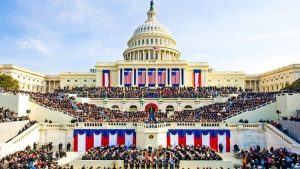 people will educate themselves on these two ideas, so that they can see how much better it is to be a Constitutional Republic.
people will educate themselves on these two ideas, so that they can see how much better it is to be a Constitutional Republic.
As the United States begins a new era, with a new president, vice president, and congress, it is my hope that we can now set aside the protesting, the hatred and racism, and the lawlessness, and become a nation that is proud and honorable…a nation that exhibits respect for one another. Congratulations to President Donald J Trump, Vice President Michael R Pence, their families, and this great nation. Happy Inauguration Day, and God bless America!!

 Captain Charles Wilkes was an American naval officer, ship’s captain, and explorer. During an exploring expedition, authorized by the May 18, 1836 act of the Congress, Wilkes set out to explore the southern oceans. Congress didn’t expect his expedition to find anything amazing, but that is where they were wrong. His group set out in 1838, and it was during this expedition that Wilkes spotted the coast of Antarctica. The group had sailed around South America to the South Pacific, and after spotting Antarctica, decided to explore a 1,500 mile stretch of it’s eastern coast. The area later became known a Wilkes Land. In 1842, the expedition returned to New York, after having circumnavigated the globe. Wilkes wasn’t the first explorer to look at Antarctica, however. It was discovered by European and American explorers, and in the February 1821, American John Davis became the first person to land on the continent, coming in at Hughes Bay on the Antarctic Peninsula.
Captain Charles Wilkes was an American naval officer, ship’s captain, and explorer. During an exploring expedition, authorized by the May 18, 1836 act of the Congress, Wilkes set out to explore the southern oceans. Congress didn’t expect his expedition to find anything amazing, but that is where they were wrong. His group set out in 1838, and it was during this expedition that Wilkes spotted the coast of Antarctica. The group had sailed around South America to the South Pacific, and after spotting Antarctica, decided to explore a 1,500 mile stretch of it’s eastern coast. The area later became known a Wilkes Land. In 1842, the expedition returned to New York, after having circumnavigated the globe. Wilkes wasn’t the first explorer to look at Antarctica, however. It was discovered by European and American explorers, and in the February 1821, American John Davis became the first person to land on the continent, coming in at Hughes Bay on the Antarctic Peninsula.
Over the next century, many nations, including the United States, wanted to stake their territorial claims to portions of the frigid continent. I’m sure they all had the same idea for its use. Obviously, it was not going to be a place where people were going to live for any length of time…at least not at first. Scientists do spend quite a bit of time there now, but back then, the necessary facilities and equipment were not available.
Finally, in the 1930s, conflicting claims finally led to international rivalry, and the United States, which led the world in the establishment of scientific bases, enacted an official policy of making no territorial claims while recognizing no other nation’s claims. While it didn’t immediately solve the conflict then, it probably set in 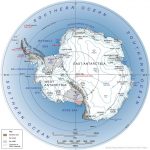
 motion, the 1959 Antarctic Treaty that made Antarctica an international zone, set guidelines for scientific cooperation, and prohibited military operations, nuclear explosions, and the disposal of radioactive waste on the continent. It’s sometimes strange to think about a continent that has really no owner, or rather is owned by the world, and yet even in modern times we have another such place…the International Soace Station. It’s nice to know that there are some things that we can share globally and actually get along.
motion, the 1959 Antarctic Treaty that made Antarctica an international zone, set guidelines for scientific cooperation, and prohibited military operations, nuclear explosions, and the disposal of radioactive waste on the continent. It’s sometimes strange to think about a continent that has really no owner, or rather is owned by the world, and yet even in modern times we have another such place…the International Soace Station. It’s nice to know that there are some things that we can share globally and actually get along.

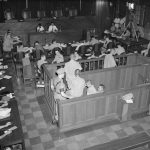 We all know that war is a nasty, messy, vicious event. Nevertheless, sometimes war is necessary. Unfortunately, in our world, evil exists, and sometimes the evil is in the form of a dictator, a nation, or a religious group. Wars might be fought differently, but the end result is the same…death and destruction. Still, most wars have an ending point. One side surrenders, and admits defeat. That might seem like the end of the story, but it isn’t. All too often the process of cleaning up the mess after the war, takes far longer than the war itself. In fact, sometimes the cleanup never really happens at all. Such was the case with landmines in Angola. These mines are a legacy of over four decades of fighting during a 14 year war of independence against its former colonial ruler of Portugal and another 30 years of civil war. Like people who put signs up to advertise a garage sale, sometimes they don’t remember where all the landmines were, or maybe they did, and simply didn’t care. Either way, the landmines were killing and maiming people…innocent people. That was the mission my 16th cousin once removed, Princess Diana took upon herself. She wanted an international ban on landmines. Her comments, which were made during a January 15, 1997 visit to Angola to see for herself some of the victims of landmines, were seen as out of step with government policy by the Junior Defense Minister, Earl Howe, who described the princess as a “loose cannon”, ill-informed on the issue of anti-personnel landmines. Nevertheless, Diana was right about the weapons of war that were left behind. The task of cleaning up the mess may have been a daunting one, but the result of leaving them behind was gruesome.
We all know that war is a nasty, messy, vicious event. Nevertheless, sometimes war is necessary. Unfortunately, in our world, evil exists, and sometimes the evil is in the form of a dictator, a nation, or a religious group. Wars might be fought differently, but the end result is the same…death and destruction. Still, most wars have an ending point. One side surrenders, and admits defeat. That might seem like the end of the story, but it isn’t. All too often the process of cleaning up the mess after the war, takes far longer than the war itself. In fact, sometimes the cleanup never really happens at all. Such was the case with landmines in Angola. These mines are a legacy of over four decades of fighting during a 14 year war of independence against its former colonial ruler of Portugal and another 30 years of civil war. Like people who put signs up to advertise a garage sale, sometimes they don’t remember where all the landmines were, or maybe they did, and simply didn’t care. Either way, the landmines were killing and maiming people…innocent people. That was the mission my 16th cousin once removed, Princess Diana took upon herself. She wanted an international ban on landmines. Her comments, which were made during a January 15, 1997 visit to Angola to see for herself some of the victims of landmines, were seen as out of step with government policy by the Junior Defense Minister, Earl Howe, who described the princess as a “loose cannon”, ill-informed on the issue of anti-personnel landmines. Nevertheless, Diana was right about the weapons of war that were left behind. The task of cleaning up the mess may have been a daunting one, but the result of leaving them behind was gruesome.
Of course, these weren’t the only messes that needed to be cleaned up after a war. There were buildings to be rebuilt, the dead to bury, the economy to build up, and the government often had to be restructured. The country might have been the enemy, but if things weren’t handled right after the surrender, the same evil people might move right back into power. Of course, cleaning up the mess…often known as policing the nation that has now surrendered, is no easy task either. Most people don’t want the winning army there. Their country is nothing like it used to be. Some believe that is a good thing, but it was still their home, and now everything feels…wrong. Their homes are destroyed, food is can be scarce…water too. Everything they have known for their whole life is gone. No wonder they don’t want the army there…or maybe they secretly do, because their home has become just a very scary place. I suppose that is why a part of the surrender agreements include restoration of the country, and the new government and police.
One more part of cleaning up the mess is the task of trying the perpetrators for their war crimes. That was the main reason that Hitler took his own life. He knew that he would be tried and convicted of the crimes he had committed, and he couldn’t face what would follow. He would have been left to the mercy of his countrymen, 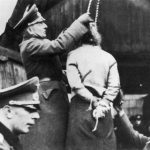
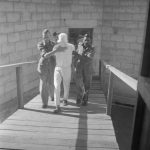 and he would have ended up being hung, like Saddam Hussein was for his war crimes. A dictator can’t brutally kill the people who he is in power over and not be hated…truly hated, no matter what the people act like when they are forced to act loyal. The trials for war crimes in many ways seems to the world, as if one nation is trying to be the world police. The United States has been accused of this before, but the reality remains, that someone has to try these evil criminals, and someone has to clean up the mess. In the absence of another nation to step up, the job usually falls to the United States.
and he would have ended up being hung, like Saddam Hussein was for his war crimes. A dictator can’t brutally kill the people who he is in power over and not be hated…truly hated, no matter what the people act like when they are forced to act loyal. The trials for war crimes in many ways seems to the world, as if one nation is trying to be the world police. The United States has been accused of this before, but the reality remains, that someone has to try these evil criminals, and someone has to clean up the mess. In the absence of another nation to step up, the job usually falls to the United States.

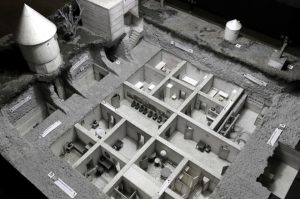 I read yesterday, that Adolf Hitler went into his underground bunker, known as the Führerbunker, with his mistress, Eva Braun on January 16, 1945. It was a coward’s move, so as not to have to face the Russians when they marched into town. He left his men to finish out the war in a losing battle, and when they wanted to surrender, they were rewarded with death. They were considered cowards, and yet Hitler made his last trip above ground on April 20, 1945, his 56th birthday. He took that opportunity, in the ruined garden of the Reich Chancellery, to award the Iron Cross to boy soldiers of the Hitler Youth, and then he retreated back to the safety of his bunker. On April 28th, Hitler learned that Reichsführer, SS Heinrich Himmler, who had left Berlin on April 20th was trying to discuss surrender terms with the Western Allies through Count Folke Bernadotte. To Hitler this was treason, and he was enraged. He ordered Himmler’s arrest. He also had Hermann Fegelein, Himmler’s SS representative at Hitler’s Headquarters in Berlin, shot. Those men were doing their best to stay alive, and Hitler sat in the safety of his bunker calling them traitors and cowards. Hitler’s bunker, while not elegant by any standard, was quite comfortable. He and Eva were well protected until the day they took their own lives on April 30, 1945…one day after their April 29th
I read yesterday, that Adolf Hitler went into his underground bunker, known as the Führerbunker, with his mistress, Eva Braun on January 16, 1945. It was a coward’s move, so as not to have to face the Russians when they marched into town. He left his men to finish out the war in a losing battle, and when they wanted to surrender, they were rewarded with death. They were considered cowards, and yet Hitler made his last trip above ground on April 20, 1945, his 56th birthday. He took that opportunity, in the ruined garden of the Reich Chancellery, to award the Iron Cross to boy soldiers of the Hitler Youth, and then he retreated back to the safety of his bunker. On April 28th, Hitler learned that Reichsführer, SS Heinrich Himmler, who had left Berlin on April 20th was trying to discuss surrender terms with the Western Allies through Count Folke Bernadotte. To Hitler this was treason, and he was enraged. He ordered Himmler’s arrest. He also had Hermann Fegelein, Himmler’s SS representative at Hitler’s Headquarters in Berlin, shot. Those men were doing their best to stay alive, and Hitler sat in the safety of his bunker calling them traitors and cowards. Hitler’s bunker, while not elegant by any standard, was quite comfortable. He and Eva were well protected until the day they took their own lives on April 30, 1945…one day after their April 29th 
 marriage. Their death came by cyanide poisoning, with Hitler’s accompanied by a self inflicted gunshot wound to the head. They did not want to face the possibility of a trial for the many war crimes he was responsible for.
marriage. Their death came by cyanide poisoning, with Hitler’s accompanied by a self inflicted gunshot wound to the head. They did not want to face the possibility of a trial for the many war crimes he was responsible for.
In what was proving to be a crumbling empire, Hitler’s death camp soldiers knew they too, were in trouble, the day after he went underground. On January 17, 1945, the Russians were approaching Auschwitz. The decision was made to evacuate most of its population and send them on a death march. It was the largest and the most notorious of the death marches. Just nine days before the Soviets arrived at the death camp at Auschwitz, the SS marched nearly 60,000 prisoners out of the camp toward Loslau, 39 miles away. There, they were put on freight trains to other camps. Approximately 15,000 prisoners died on the way, which is why it was called a death march. Loslau recorded a freezing -4°F and lower at the time the prisoners were arriving. Residents tried to help the prisoners, and many prisoners regained freedom between Auschwitz and Loslau, as the residents helped them escape. The prisoners who were left at the camp were liberated on 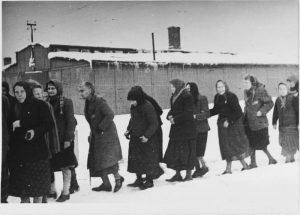
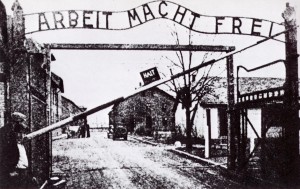 January 27, 1945, which is a day now commemorated as International Holocaust Remembrance Day. In years after the Holocaust, survivors, such as Primo Levi, Viktor Frankl, and Elie Wiesel, wrote memoirs of their experiences in Auschwitz, and the camp became a dominant symbol of the Holocaust. In 1947, Poland founded the Auschwitz-Birkenau State Museum on the site of Auschwitz I and II, and in 1979, it was named a UNESCO World Heritage Site.
January 27, 1945, which is a day now commemorated as International Holocaust Remembrance Day. In years after the Holocaust, survivors, such as Primo Levi, Viktor Frankl, and Elie Wiesel, wrote memoirs of their experiences in Auschwitz, and the camp became a dominant symbol of the Holocaust. In 1947, Poland founded the Auschwitz-Birkenau State Museum on the site of Auschwitz I and II, and in 1979, it was named a UNESCO World Heritage Site.
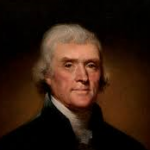 With everyone arguing about whether or not religion has a place in politics, today seemed a good day to discuss the common misconception people have about the constitutional amendment they so often quote as the basis for their arguments. Our founding fathers came to this country, largely because in England they were forced to attend the Church of England…by law. Whether they agreed or not, or even whether the church was teaching correctly or not, was completely irrelevant. That was the church, and that was where people were expected to go. For any who wonder why so many of us are against the influx of Muslims, this is the reason…not because we disagree with their religion, but because it is the goal of Islam to force the entire world to convert to Islam. Our founding fathers, and indeed most Americans believe so strongly in the right to choose which religion, or even the lack of a religion, we want to practice, that we are willing to fight to keep that right. This amendment is simply not negotiable.
With everyone arguing about whether or not religion has a place in politics, today seemed a good day to discuss the common misconception people have about the constitutional amendment they so often quote as the basis for their arguments. Our founding fathers came to this country, largely because in England they were forced to attend the Church of England…by law. Whether they agreed or not, or even whether the church was teaching correctly or not, was completely irrelevant. That was the church, and that was where people were expected to go. For any who wonder why so many of us are against the influx of Muslims, this is the reason…not because we disagree with their religion, but because it is the goal of Islam to force the entire world to convert to Islam. Our founding fathers, and indeed most Americans believe so strongly in the right to choose which religion, or even the lack of a religion, we want to practice, that we are willing to fight to keep that right. This amendment is simply not negotiable.
Nevertheless, the misconception comes when people misstate the first amendment, claiming that it means that religion has no place in politics. That statement is fundamentally wrong, and not what Thomas Jefferson had in mind when in 1779, he wrote the “Bill for Establishing Religious Freedom.” America was settled by people who wanted religious freedom, and Jefferson believed in freedom of religion, too. He didn’t believe that churches 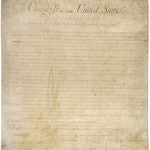 should be funded by taxes, thereby giving the government authority in the beliefs of the church. The bill said that “no man shall be compelled (forced) to frequent (go to) or support any religious worship, place or ministry whatsoever.” Some people were against it even then, and it did not become law at that time. It did, however, create a friendship between Jefferson and James Madison, who believed the say way.
should be funded by taxes, thereby giving the government authority in the beliefs of the church. The bill said that “no man shall be compelled (forced) to frequent (go to) or support any religious worship, place or ministry whatsoever.” Some people were against it even then, and it did not become law at that time. It did, however, create a friendship between Jefferson and James Madison, who believed the say way.
In 1784, Jefferson left for Paris, France to perform his duties as US foreign minister to France. That left James Madison with the task of making the bill into law. No easy task, because it had failed on its first attempt. Undaunted, Madison presented the bill to the Virginia Assembly, and with a few minor changes, it passed in 1786. Elated, Madison sent word to Jefferson in Paris. When the bill passed, Virginia became the first state to free religions from state rule. It is still part of Virginia’s constitution. It was used as a model for other state’s constitutions. It was also used as a model for the religious language in the Bill of Rights: “Congress shall make no law respecting an establishment of religion, or prohibiting the free exercise thereof.” If people would read the Constitutional amendment and the Bill of Rights carefully, they would, indeed find that it says nothing at all about keeping religion out of politics, and everything about keeping the government out of religions. Thomas 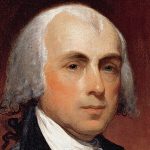 Jefferson believed the Virginia Statute of Religious Freedom was one of his greatest achievements. So strongly did he believe in his accomplishments, that he wanted his tombstone to list the “things that he had given the people.” It reads: “Here was buried Thomas Jefferson Author of the Declaration of Independence of The Statute of Virginia for Religious Freedom And Father of the University of Virginia.” Why did Jefferson want the Statute for Religious Freedom on his tombstone? It was because he could see what could happen when one religion was allowed to hold hostage the rest of the nation, or indeed, the world. That is why we will never give up the fight, and we will oppose all religions that would try to force themselves on us. People should stop using this convenient misconception to try to further their own agendas in this nation.
Jefferson believed the Virginia Statute of Religious Freedom was one of his greatest achievements. So strongly did he believe in his accomplishments, that he wanted his tombstone to list the “things that he had given the people.” It reads: “Here was buried Thomas Jefferson Author of the Declaration of Independence of The Statute of Virginia for Religious Freedom And Father of the University of Virginia.” Why did Jefferson want the Statute for Religious Freedom on his tombstone? It was because he could see what could happen when one religion was allowed to hold hostage the rest of the nation, or indeed, the world. That is why we will never give up the fight, and we will oppose all religions that would try to force themselves on us. People should stop using this convenient misconception to try to further their own agendas in this nation.
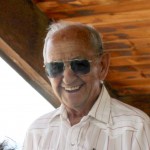 Have you ever noticed that some children have a look on their face that tells you that they are a comedian at heart. I didn’t know my Uncle Wayne Byer when he was a little boy, but I have no doubt that he was a child comedian, because it was written all over his face. Uncle Wayne as a child always wore a mischievous smile. That smile, and the mischievousness that went with it, have never left him. In fact, I think they are one of the most endearing qualities Uncle Wayne has…to me anyway. When I think of him, I remember all the funny things he has done and how much he made us all laugh. What a great legacy for a person. A legacy of laughter. There are few things that make a person more memorable than the ability to make people laugh. Uncle Wayne has that.
Have you ever noticed that some children have a look on their face that tells you that they are a comedian at heart. I didn’t know my Uncle Wayne Byer when he was a little boy, but I have no doubt that he was a child comedian, because it was written all over his face. Uncle Wayne as a child always wore a mischievous smile. That smile, and the mischievousness that went with it, have never left him. In fact, I think they are one of the most endearing qualities Uncle Wayne has…to me anyway. When I think of him, I remember all the funny things he has done and how much he made us all laugh. What a great legacy for a person. A legacy of laughter. There are few things that make a person more memorable than the ability to make people laugh. Uncle Wayne has that.
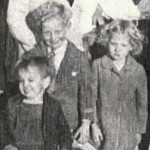
My mother, Collene Spencer was the middle child in the family, and the middle child between the only two boys. In my mind, they were like the three musketeers. Where one was found getting into mischief, the other two were not far behind. That’s how it is with siblings sometimes. Different groups of siblings are closer than other groups, even if it is only during their childhood. My mom and her brothers probably drove my grandma crazy with their antics. My mom, aunts, and uncles used to get together once a month to have lunch, visit, and talk about old times. Sometimes, I would like to have been a fly on the wall while they told those stories.
Of course, time changes things, and kids grow up and find different things to spend 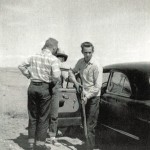 time doing. My uncles used to go hunting with their dad to help supply food for the family. Slowly, childhood days slipped away, and Uncle Wayne, like all kids became an adult, has a family, and worked a job until it was time for him to retire, but he never lost his sense of humor. I think too, that the antics of the three middle children was a source of much laughter in conversations when the siblings got together is their adult years. Uncle Wayne is the last of the three musketeers left now, and that makes me very sad. I can still hear the laughter when all the siblings got together, and I really hate the fact that four of the nine are gone. I’m glad we still have Uncle Wayne though, and his great sense of humor. Today is Uncle Wayne’s 79th birthday. Happy birthday Uncle Wayne!! Have a great day!! We love you!!
time doing. My uncles used to go hunting with their dad to help supply food for the family. Slowly, childhood days slipped away, and Uncle Wayne, like all kids became an adult, has a family, and worked a job until it was time for him to retire, but he never lost his sense of humor. I think too, that the antics of the three middle children was a source of much laughter in conversations when the siblings got together is their adult years. Uncle Wayne is the last of the three musketeers left now, and that makes me very sad. I can still hear the laughter when all the siblings got together, and I really hate the fact that four of the nine are gone. I’m glad we still have Uncle Wayne though, and his great sense of humor. Today is Uncle Wayne’s 79th birthday. Happy birthday Uncle Wayne!! Have a great day!! We love you!!
 With the development of weapons of mass destruction, comes the distinct possibility of serious accidents. For the most part the weapons are designed to be fairly stable under most circumstances, but that was not always the case, nor is it always the case today. Nitroglycerin, when it was first developed was a volatile liquid that would explode if it was shaken too much. Many miners, hauling the liquid to the mines by wagon, were killed when the nitroglycerin was shaken. In fact it was considered such a hazardous occupation, that the men doing it were given hazard pay, and still not many would haul it.
With the development of weapons of mass destruction, comes the distinct possibility of serious accidents. For the most part the weapons are designed to be fairly stable under most circumstances, but that was not always the case, nor is it always the case today. Nitroglycerin, when it was first developed was a volatile liquid that would explode if it was shaken too much. Many miners, hauling the liquid to the mines by wagon, were killed when the nitroglycerin was shaken. In fact it was considered such a hazardous occupation, that the men doing it were given hazard pay, and still not many would haul it.
The same possibility exists with today’s weapons, as was exhibited on 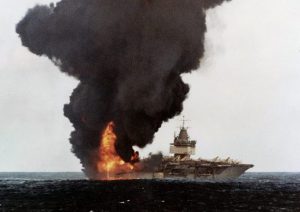 January 14, 1969, on board the USS Enterprise, a United States Naval Aircraft Carrier, while being escorted by the destroyers Benjamin Stoddert and Rogers. On that fateful day a MK-32 Zuni rocket that was loaded on a parked F-4 Phantom exploded when it became overheated due to the exhaust from another plane. The rocket blew up, setting off a chain reaction of explosions. Fires broke out across the deck of the ship, then the jet fuel flowed into the carrier’s interior, and more fires were sparked. Many of the Enterprise’s fire-protection features failed to work properly, but the crew worked heroically and tirelessly to extinguish the fire.
January 14, 1969, on board the USS Enterprise, a United States Naval Aircraft Carrier, while being escorted by the destroyers Benjamin Stoddert and Rogers. On that fateful day a MK-32 Zuni rocket that was loaded on a parked F-4 Phantom exploded when it became overheated due to the exhaust from another plane. The rocket blew up, setting off a chain reaction of explosions. Fires broke out across the deck of the ship, then the jet fuel flowed into the carrier’s interior, and more fires were sparked. Many of the Enterprise’s fire-protection features failed to work properly, but the crew worked heroically and tirelessly to extinguish the fire.
Twenty seven sailors lost their lives due to the tragedy that day, and another 314 men were seriously injured. Although 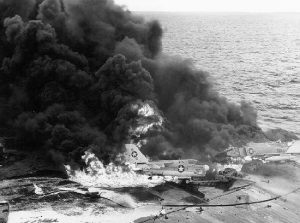 fifteen of the thirty two aircraft onboard the Enterprise at the time were destroyed by explosions and fire, it was determined that the enterprise itself was not in danger of sinking. When compared to previous carrier flight deck fires, the fires on the Enterprise were brought under control relatively quickly. The main repairs were to the flight deck’s armored plating. The ship spent several months at Pearl Harbor Naval Shipyard, Hawaii being repaired and was returned to action on March 1, 1969, when she shipped out to her scheduled western Pacific (WESTPAC) deployment to Vietnam and the Tonkin Gulf. These destinations would be delayed by events in the eastern Sea of Japan.
fifteen of the thirty two aircraft onboard the Enterprise at the time were destroyed by explosions and fire, it was determined that the enterprise itself was not in danger of sinking. When compared to previous carrier flight deck fires, the fires on the Enterprise were brought under control relatively quickly. The main repairs were to the flight deck’s armored plating. The ship spent several months at Pearl Harbor Naval Shipyard, Hawaii being repaired and was returned to action on March 1, 1969, when she shipped out to her scheduled western Pacific (WESTPAC) deployment to Vietnam and the Tonkin Gulf. These destinations would be delayed by events in the eastern Sea of Japan.
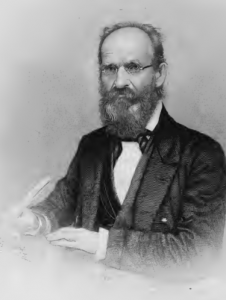 Platt Rogers Spencer, who is my 3rd cousin 5 times removed, was a social activist. In other words, he saw something that was socially or morally wrong, such as slavery, and he actively fought against it. These days that would mean protesting, lobbying, and blogging against it. Social activism has it’s place, but should be done in the proper way. Platt Spencer was a zealous promoter of the antislavery movement…an honorable cause. He was a prominent advocate of the abstinence movements. He was instrumental in founding business colleges in the United States, and was in organizing several business colleges in the United States, and he was an instructor in business colleges throughout the country.
Platt Rogers Spencer, who is my 3rd cousin 5 times removed, was a social activist. In other words, he saw something that was socially or morally wrong, such as slavery, and he actively fought against it. These days that would mean protesting, lobbying, and blogging against it. Social activism has it’s place, but should be done in the proper way. Platt Spencer was a zealous promoter of the antislavery movement…an honorable cause. He was a prominent advocate of the abstinence movements. He was instrumental in founding business colleges in the United States, and was in organizing several business colleges in the United States, and he was an instructor in business colleges throughout the country.
In 1815, Spencer taught his first writing class, and in New York, where he founded the Spencer Seminary in Jericho, housed in a log cabin. From 1816 to 1821, he was a clerk and a book keeper and, from 1821 to 1824, he studied in law, Latin, English literature and penmanship. He also taught in a common school and wrote up merchants’ books. 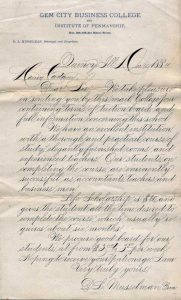 In 1824, he contemplated entering college with a view to preparing for the ministry, but, due to his alcoholism, which was aggravated by the prevalent drinking customs of the time, he did not. He struggled with alcoholism for a number of years. He then taught in Ohio, where in 1832, he was able to withdraw from alcohol completely, becoming a total abstainer. He advocated abstaining from alcohol for the remainder of his life. Soon after his recovery from alcoholism, he was elected to public office, as county treasurer of Ashtabula County, Ohio for twelve years. He also was a founding member of the Ashtabula County Historical Society established in 1838 and he was instrumental in collecting the early history of Ashtabula County, Ohio.
In 1824, he contemplated entering college with a view to preparing for the ministry, but, due to his alcoholism, which was aggravated by the prevalent drinking customs of the time, he did not. He struggled with alcoholism for a number of years. He then taught in Ohio, where in 1832, he was able to withdraw from alcohol completely, becoming a total abstainer. He advocated abstaining from alcohol for the remainder of his life. Soon after his recovery from alcoholism, he was elected to public office, as county treasurer of Ashtabula County, Ohio for twelve years. He also was a founding member of the Ashtabula County Historical Society established in 1838 and he was instrumental in collecting the early history of Ashtabula County, Ohio.
In 1840, Platt developed a beautiful and unique style of writing and named it after himself, calling it Spencerian Script. The penmanship style quickly became the standard in the United States from 1850 to 1925. It was considered the American de facto standard writing style for business correspondence prior to the widespread adoption of the typewriter. Platt used various existing styles as the inspiration for his unique oval-based style. His style could be written quickly and legibly and yet it still looked elegant, which made it perfect for business 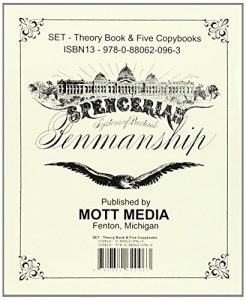 correspondence, as well as personal letters. Immediately following his development of the Spencerian Script style, Platt began teaching it in the schools he established for the purpose of teaching his penmanship style. As soon as his students began to graduate, they started replicas of the Spencerian Script abroad, and then in 1850 it reached the common schools. Unfortunately, Platt Spencer never got to see the full success of his unique penmanship, because he died on May 16, 1864. Nevertheless, his sons made it their mission to bring their late father’s dream to fruition. They accomplished that feat by distributing Spencer’s previously unpublished book, Spencerian Key to Practical Penmanship, in 1866. Spencerian Script was gradually replaced in primary schools with the simpler Palmer Method developed by Austin Norman Palmer…which is sadly very plain by comparison. The Coca-Cola Company famously used Spencerian Script in its now famous logo, and continues to do so to this day.
correspondence, as well as personal letters. Immediately following his development of the Spencerian Script style, Platt began teaching it in the schools he established for the purpose of teaching his penmanship style. As soon as his students began to graduate, they started replicas of the Spencerian Script abroad, and then in 1850 it reached the common schools. Unfortunately, Platt Spencer never got to see the full success of his unique penmanship, because he died on May 16, 1864. Nevertheless, his sons made it their mission to bring their late father’s dream to fruition. They accomplished that feat by distributing Spencer’s previously unpublished book, Spencerian Key to Practical Penmanship, in 1866. Spencerian Script was gradually replaced in primary schools with the simpler Palmer Method developed by Austin Norman Palmer…which is sadly very plain by comparison. The Coca-Cola Company famously used Spencerian Script in its now famous logo, and continues to do so to this day.
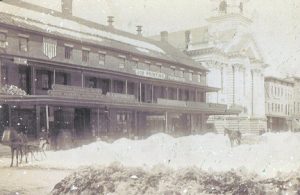 With all of the extreme weather shows, warnings, and education we have access to these days, one would think that blizzard related deaths would quickly become a thing of the past, but it never seems to go that way exactly. Nevertheless, it used to be much worse. In bygone years, the warnings we have today simply didn’t exist, and blizzards were very much feared by the people, and with good reason too. The storms would come up, seemingly without notice, and I suppose that was how it was. People couldn’t turn on their radio, television, computers, or smart phones, and get the weather forecast. They could look at the sky and feel the temperature changing, and maybe guess at what was coming, but if they were wrong, it could be deadly. Such was the case on January 12, 1888, when a blizzard blew into the Northwest Plains region of the United States with little or no warning. Some people said that the temperature dropped 100° in just 24 hours. A lot maybe, but I’ve seen temperature changes of more than 60°, so it’s possible.
With all of the extreme weather shows, warnings, and education we have access to these days, one would think that blizzard related deaths would quickly become a thing of the past, but it never seems to go that way exactly. Nevertheless, it used to be much worse. In bygone years, the warnings we have today simply didn’t exist, and blizzards were very much feared by the people, and with good reason too. The storms would come up, seemingly without notice, and I suppose that was how it was. People couldn’t turn on their radio, television, computers, or smart phones, and get the weather forecast. They could look at the sky and feel the temperature changing, and maybe guess at what was coming, but if they were wrong, it could be deadly. Such was the case on January 12, 1888, when a blizzard blew into the Northwest Plains region of the United States with little or no warning. Some people said that the temperature dropped 100° in just 24 hours. A lot maybe, but I’ve seen temperature changes of more than 60°, so it’s possible.
It was a Thursday afternoon and the weather had been unseasonably warm the previous day from Montana, east to the Dakotas, and south to Texas. Within a matter of hours, the Artic front blew in, plunging the temperature to 40° below zero in much of North Dakota. The freezing temperatures were joined by high winds and heavy snow. It was lethal combination that created a blinding blizzard, just when the children were on their 
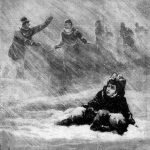
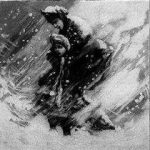 way home from school. The storm, coupled with the time of day, set the stage for a disaster, and unfortunately it would take the lives of 235 people…mostly children making their way home from school in rural areas and adults working on large farms. Both of these groups of people were taken by surprise, and were unable to find their way to their destinations.
way home from school. The storm, coupled with the time of day, set the stage for a disaster, and unfortunately it would take the lives of 235 people…mostly children making their way home from school in rural areas and adults working on large farms. Both of these groups of people were taken by surprise, and were unable to find their way to their destinations.
Some areas decided to err on the side of caution, and that resulted in lives saved. Schoolteacher, Seymour Dopp in Pawnee City, Nebraska, kept his 17 students at school when the storm began at 2 pm. They stayed overnight, burning stockpiled wood to keep warm. The next day, parents made their way over five foot snow drifts to rescue their children. I’m sure they were wondering if they would ever see their children again, because they couldn’t call to check on them, after all. Some areas ha drifts over ten feet too. In Great Plains, 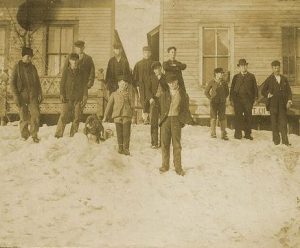 South Dakota, two men rescued the children in a schoolhouse by tying a rope from the school to the nearest shelter to lead them to safety. Minnie Freeman, a Nebraska teacher, successfully led her children to shelter after the storm tore the roof off of her one room schoolhouse. Sadly, not all efforts to save the children were successful. Teacher Loie Royce tried to lead three children to the safety of her home, which was less than 90 yards from their school in Plainfield, Nebraska. They all became lost. The children died of hypothermia, and Royce lost her feet to frostbite. The January 12th storm was dubbed the Schoolchildren’s Blizzard, because most of the 235 victims were children. It is considered one of the worst blizzards in the history of the area, to this day.
South Dakota, two men rescued the children in a schoolhouse by tying a rope from the school to the nearest shelter to lead them to safety. Minnie Freeman, a Nebraska teacher, successfully led her children to shelter after the storm tore the roof off of her one room schoolhouse. Sadly, not all efforts to save the children were successful. Teacher Loie Royce tried to lead three children to the safety of her home, which was less than 90 yards from their school in Plainfield, Nebraska. They all became lost. The children died of hypothermia, and Royce lost her feet to frostbite. The January 12th storm was dubbed the Schoolchildren’s Blizzard, because most of the 235 victims were children. It is considered one of the worst blizzards in the history of the area, to this day.

